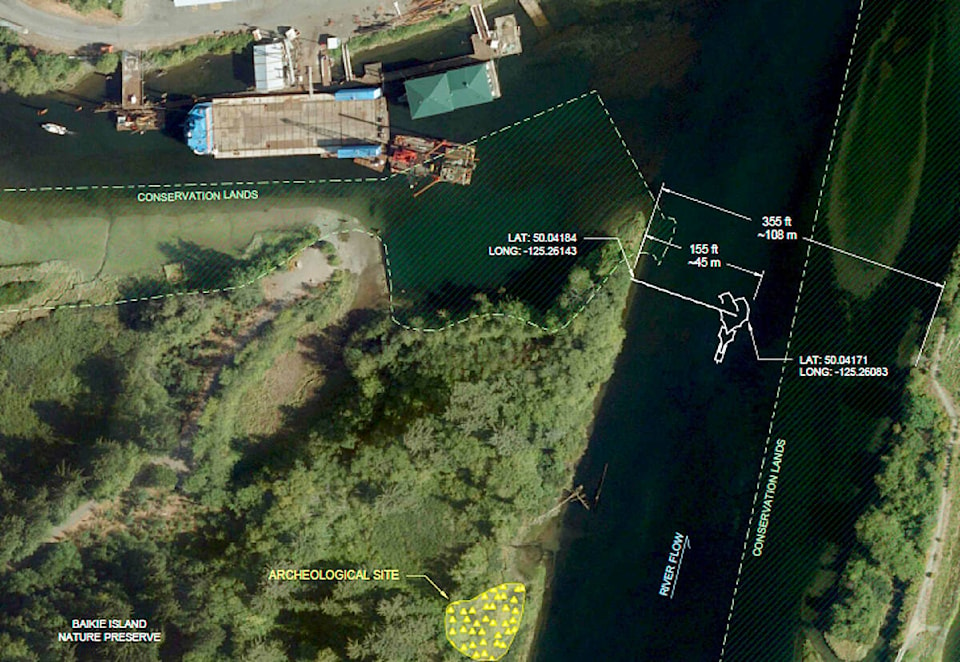Construction is expected to begin this summer on a fish trap on the Campbell River estuary that will selectively harvest hatchery-marked salmon from August to November of 2025.
The $1,143,114 million project is funded by DFO’s BC Salmon Restoration and Innovation Fund (BCSRIF) and will provide salmon for three local First Nations to meet food, social and ceremonial needs. The project is a partnership of A-Tlegay Fisheries Society, the We Wai Kai First Nation, Wei Wai Kum First Nation, LGL Limited and Wild Fish Conservancy.
According to information on the BCSRIF website, the project involves the assessment, design, construction and operation of a tidal waters selective fishery salmon trap close to a traditional First Nation fishing site in the Campbell/Quinsam rivers estuary.
“Historically, heart and chevron-shaped traps were used extensively by First Nation communities along the estuary to capture adult salmon prior to the development of commercial fisheries,” BCSRIF says. “Recent revitalization of fish traps as a terminal fishery in other areas along the coast has been shown to be successful at catching and selectively harvesting hatchery marked salmon species while releasing wild (unmarked) salmon and steelhead of conservation concern.”
The initiative will develop First Nations’ capacity for sustainable salmon stewardship through the development of the best selective harvest fishing methods possible in traditional fishing areas while preserving wild stocks of conservation concern.
The structure will be comprised of approximately 29 piles driven in a line perpendicular from the west bank, which is the northeast corner of Baikie Island. Additional piles will create the heart of the trap at the end, extending a total of approximately 45 metres from the bank. Black nylon mesh nets are proposed to be strung between the pilings from the shore to the heart of the trap for part of the year when the trap is in use. The net is proposed to be removed but the pilings to remain when the trap is not in use.
All works and infrastructure related to the fish trap will be located in-river, below the high-water mark, and accessed by boat from the mouth of the river.
Transport Canada has begun informing potential waterfront property and vessel owners or operators on the affected reach of the river. A letter notifying nearby parties has been sent by Roberta Dight, Transport Canada A/Regional Manager, Navigation Protection Program. Comments are being sought by Transport Canada on the potential impact of the structure on operators’ ability to navigate past the site. A separate public notification and comment period may be initiated by the proponent in the near future. The deadline for comments is March 12, 2024.
Documents filed with Transport Canada say the objectives of the project are to:
1) identify and assess a suitable trap site for catching salmon with the Campbell River estuary;
2) design and build a terminal fish trap for selective harvest; and
3) operate a terminal fish trap for local First Nations to meet food, social and ceremonial needs.
An assessment of potential trap sites in the lower Campbell River was conducted from July to October 2023 using gillnetting and sonar. This lead to the selection of the proposed site. The site was chosen because it is a passage corridor for migrating salmon and has sufficient depth to accommodate the trap infrastructure and allow it to fish through the tidal cycle. The site is also upstream of most marinas in the river which is expected to minimize interactions with boat traffic.
Responding to a Mirror query, DFO communications advisor Michelle Rainer, stated that several federal and provincial authorizations will be required for this project:
- The project will require a scientific licence from Fisheries and Oceans Canada (DFO) in order to collect fish. There will be no retention of fish in the first year of the project.
- DFO’s Fish and Fish Habitat Protection Program (FFHPP) has received a Request for Review for this project and is currently reviewing the proposal as well as working with the proponent regarding measures to avoid and mitigate potential impacts to fish (death of fish by means other than fishing) and fish habitat during pile driving for the trap construction.
- As proposed pile driving related to trap construction involves changes in and about a stream, approval for construction and placement of the fish trap will require review by the Province of British Columbia for compliance with the BC Water Sustainability Act and Water Sustainability Act subsections 11(1) and 11(2).
- Transport Canada approval is required for construction and placement of the trap as it relates to navigational concerns.
EDITOR’S NOTE: This story has been updated with a response from DFO communications.
